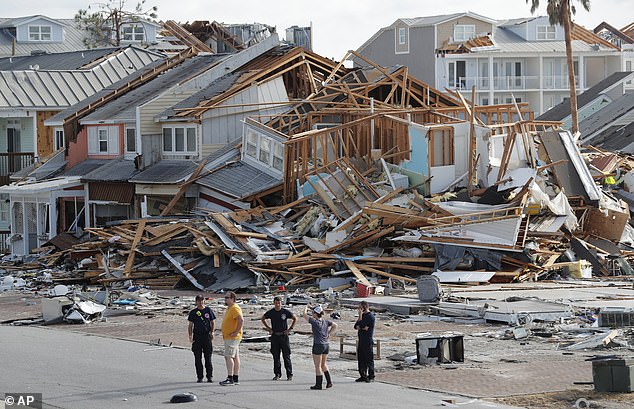Increasing numbers of Americans are using this simple method to cut their home insurance bill – but here’s why it is a risk
Americans are buying homeowners insurance policies with higher and higher deductibles in an effort to mitigate soaring premiums — but experts warn that this strategy carries risks.
The home insurance deductible is the amount a homeowner will have to pay out of pocket before the insurer contributes to the cost of a claim.
Higher deductibles generally mean lower premiums, but you could find yourself trapped if your home is vulnerable to damage.
In 2023, new homeowners insurance policies with deductibles above $2,000 increased 44% from the previous year, while those with deductibles as low as $500 were down 16%, according to the data from the Matic insurance agency.
This market shift comes as the national average for homeowners insurance premiums is skyrocketing. According to Bankrate, the average coverage for a $250,000 home increased 20% from 2022 to $1,428 per year.
In 2023, new home insurance policies with deductibles above $2,000 increased 44% from the previous year, while those with deductibles as low as $500 decreased 16%, data shows from Matic Insurance.
Homeowners in areas prone to natural disasters, such as Florida, are facing an even higher rate – with some people having to pay up to $6,000 a year for coverage – as businesses find it increasingly difficult to realize benefits.
In July, national insurer Farmers Insurance became the latest company to announce it would no longer cover homes or cars in the state, citing the growing risk of hurricanes.
For new policies effective in 2023, the proportion of deductibles between $1,000 and $1,500 decreased by 10 percent from the previous year, while those between $2,000 and $2,500 increased by 46 percent. hundred, according to Matic data.
Nonetheless, the $1,000 to $1,500 range remained the most common in 2023 – with 70.75% of homeowners still having deductibles in this range.

Charles Nyce, associate professor of risk management and insurance at Florida State University’s College of Business, suggested that consumers should consider protecting their homes against natural disasters to reduce premiums.
Rising premiums are causing some people to abandon insurance altogether.
As of June this year, 88 percent of homeowners were insured nationwide, up from 95 percent in 2016, according to the Insurance Information Institute.
For homeowners, increasing their deductible can be a strategy to lower their premium, while ensuring they still have coverage.
While some homeowners take it upon themselves to increase their deductible, others are actively encouraged to do so by their insurer, according to Matic.
But people should be prepared to cover the promised portion of a deductible if and when a loss occurs, cautions Charles Nyce, associate professor of risk management and insurance at Florida State University’s College of Business.
Many deductibles are expressed as fixed amounts, but others are expressed as a percentage of the home insurance premium, usually between 1 and 10 percent of its value.
There are also different types that consumers can opt for. While standard insurance covers wind and hail damage from storms and hurricanes, separate natural disasters are usually covered by their own deductibles.
In Florida, one of the most common measures imposed on homeowners insurance is a 2 percent deductible for hurricane losses, according to Nyce.
This means that homeowners will be responsible for the first 2 percent of the home’s insured value in the event of a loss. For a $500,000 house, that will be $10,000.
“Many households cannot afford to absorb a $10,000 loss,” Nyce said.
“There is a real risk that many policyholders will not be able to meet their excess, which could delay repairs and/or not be able to recover all losses.
“For example, he may be able to repair the house, but not replace any of the damaged goods. »

In Florida, one of the most common measures imposed on homeowners insurance is a 2% deductible for hurricane losses. The photos show rescue workers conducting searches following Hurricane Michael in Mexico Beach, Florida, in 2018.
Nyce suggested there are other steps consumers can take to best insure their homes.
First, he advised making an effort each year to actively seek out new coverage. “You may be able to find an insurer with a lower premium,” he said.
He also said consumers should pay attention to their limit, which is the highest amount the insurer will pay for a claim. While it is important to ensure that the amount will cover the cost of a rebuild or repair, it does not have to be unnecessarily high.
Finally, homeowners should find out what discounts are available and what steps they need to take to access them. For example, Nyce said that in Florida, discounts are available for taking steps to protect a home from hurricanes and there may be grants to fund completion of that work.
